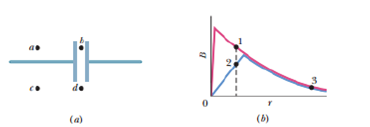
Concept explainers
Figure 32-19a shows a capacitor, with circular plates, that is being charged. Point a (near one of the connecting wires) and point b (inside the capacitor gap) are equidistant from the central axis, as are point c (not so near the wire) and point d (between the plates but outside the gap). In Fig. 32-19b, one curve gives the variation with distance r of the magnitude of the magnetic field inside and outside the wire. The other curve gives the variation with distance r of the magnitude of the magnetic field inside and outside the gap. The two curves partially overlap. Which of the three points on the curves correspond to which of the four points of Fig. 32-19a?

Figure 32-19 Question 1.
To find:
The three points on the curve in Fig 32.19 b corresponding to four points of Fig.32-19a.
Answer to Problem 1Q
Solution:
Point 1 on the curve corresponds to a, Pont 2 on the curve corresponds to b, and point 3 on the curve corresponds to c and d.
Explanation of Solution
1) Concept:
We can find the relation between magnetic field and distance from central axis from the formulae for magnetic field inside and outside the circular capacitor. Using this and analyzing the graph and the given figure, we can find the three points on the curve corresponding to four points of Fig.32-19a.
2) Formulae:
i) Inside a circular capacitor, magnetic field is
ii) Outside a circular capacitor, magnetic field is
3) Given:
Figure 32-19a and 32-19b.
Points a and b are equidistant from the central axis. Also points c and d are equidistant from it.
4) Calculations:
The magnetic field at a point inside the capacitor is given by
It implies that
The curve on which point 2 is present satisfies this condition, and there is only one point inside the capacitor b.
Hence, point 2 corresponds to point b.
The magnetic field at a point outside the capacitor is given by
It implies that
The points 1 and 3 are on the curves satisfies this relation.
Since point a and point b are equidistant, therefore we can say that point 1 corresponds to point a.
Remaining point 3 corresponds to points c and d.
Conclusion:
Inside a circular capacitor, the magnetic field is proportional to the distance from the center of the circular plate while outside the circular capacitor, it is inversely proportional the distance from the center of the circular plate.
Want to see more full solutions like this?
Chapter 32 Solutions
Fundamentals of Physics Extended
Additional Science Textbook Solutions
Chemistry: Structure and Properties (2nd Edition)
The Cosmic Perspective (8th Edition)
Cosmic Perspective Fundamentals
Microbiology: An Introduction
College Physics: A Strategic Approach (3rd Edition)
Biology: Life on Earth with Physiology (11th Edition)
- Mick and Rick are twins born on Earth in the year 2175. Rick grows up to be an Earth-bound robotics technician while Mick becomes an intergalactic astronaut. Mick leaves the Earth on his first space mission in the year 2200 and travels, according to his clock, for 10 years at a speed of 0.75c. Unfortunately, at this point in his journey, the structure of his ship undergoes mechanical breakdown and the ship explodes. How old is Rick when his brother dies?arrow_forwardHi, I have canceled, why did you charge me again?arrow_forwardNo chatgpt pls will upvotearrow_forward

 Physics for Scientists and Engineers: Foundations...PhysicsISBN:9781133939146Author:Katz, Debora M.Publisher:Cengage Learning
Physics for Scientists and Engineers: Foundations...PhysicsISBN:9781133939146Author:Katz, Debora M.Publisher:Cengage Learning Principles of Physics: A Calculus-Based TextPhysicsISBN:9781133104261Author:Raymond A. Serway, John W. JewettPublisher:Cengage Learning
Principles of Physics: A Calculus-Based TextPhysicsISBN:9781133104261Author:Raymond A. Serway, John W. JewettPublisher:Cengage Learning College PhysicsPhysicsISBN:9781305952300Author:Raymond A. Serway, Chris VuillePublisher:Cengage Learning
College PhysicsPhysicsISBN:9781305952300Author:Raymond A. Serway, Chris VuillePublisher:Cengage Learning College PhysicsPhysicsISBN:9781285737027Author:Raymond A. Serway, Chris VuillePublisher:Cengage Learning
College PhysicsPhysicsISBN:9781285737027Author:Raymond A. Serway, Chris VuillePublisher:Cengage Learning Physics for Scientists and Engineers, Technology ...PhysicsISBN:9781305116399Author:Raymond A. Serway, John W. JewettPublisher:Cengage Learning
Physics for Scientists and Engineers, Technology ...PhysicsISBN:9781305116399Author:Raymond A. Serway, John W. JewettPublisher:Cengage Learning





